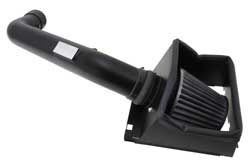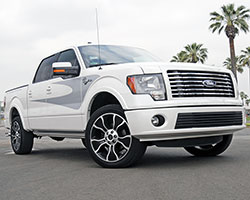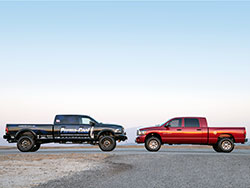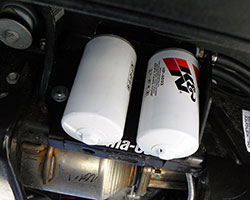
The 2015 Ford Mustang GT is powered by the 5.0-liter, 302 cubic inch Coyote motor |
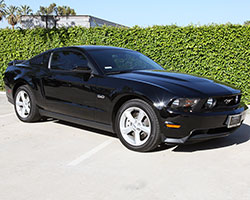
The 2011 model year saw the Ford Motor Company bring back the 5.0-liter V8 engine, absent since 1995, to power the 2011-2014 Ford Mustang GT as well as the Ford F150 pickup truck |
The legendary Ford Mustang was first introduced in April of 1964. The car debuted too late to be considered a 1964 model, and too early to be considered a 1965 model. Most Mustang enthusiasts will refer to the first model year Mustang as a 1964 ½ model, however the Ford Motor Company marketed these early cars as 1965 models. This led to the cars introduced in April 1964 to be referred to as “Early ‘65’s”, and Mustangs sold during the regular 1965 model year as “Late ‘65’s” due to the significant changes made five months after the Mustang’s introduction at the 1964 World’s Fair.

2005, 2006, 2007, 2008, and 2009 Ford Mustang GT models with a 4.6L V8 engine can improve performance with the 33-2298 replacement K&N reusable air filter |
One of the most significant changes for the regular 1965 model year was the introduction of the Mustang GT as the "GT Equipment Package." For 1965 the GT Equipment package included a standard V8 engine, grille-mounted fog lamps, rocker panel stripes, and disc brakes. The GT Equipment Package option added a different instrument panel in the interior that included a speedometer, fuel gauge, temperature gauge, oil pressure gauge and ammeter in five round dials.
While Ford may have introduced other Mustang performance packages, such as the GT350H, Cobra, SVT, Mach 1, and Boss, the Mustang GT is the most enduring sub-model over the Mustang’s 50 years in production. K&N has made upgrading your Mustang GT easy with performance options that range from a stock replacement performance air filter, to short ram intake and cold air intake systems to reduce restriction, straighten airflow, and increase performance. A K&N air intake system is designed to provide a guaranteed increase in performance. This bolt on performance upgrade can usually be installed in around 90 minutes, and gives one of the best performance bangs for your buck.
2015-2017 Sixth Generation Mustang GT 5.0-liter V8 models
The sixth generation Ford Mustang GT was revealed to the public in time to commemorate the fiftieth anniversary of the Ford Mustang. The 2015 Mustang is an evolution in design from the 2005-2014 fifth generation, while still taking styling cues from classic Mustangs. One feature incorporated into the sixth gen Mustang which sets it apart from its predecessors is the fully independent rear suspension as well as being the first Mustang to be marketed and sold globally.

K&N air intake 63-2578, for 2011-2014 Ford Mustang GT 5.0L models features a rotomolded air intake tube, and an enclosed air box with a carbon fiber lid to provide an estimated 20.27 more horsepower over stock |

The 2005 Mustang was styled after a 2003 concept car, taking much inspiration from the first generation 1964-1970 Mustang and sparked renewed interest in the pony car market |
The 2015-2016 Ford Mustang GT is powered by the 5.0-liter, 302 cubic inch, Coyote motor carried over from the 2011-2014 Mustang GT. Power output is rated at 435 horsepower and 400 lb-ft of torque. These are impressive power numbers from a naturally aspirated 5.0-liter V8, however K&N engineers developed a replacement air filter part 33-5029 and an air intake part 63-2590 designed to get even more power out of the 2015-2017 Mustang GT. K&N 63-2590 added an impressive estimated 17.41 horsepower at 5287 RPM.
2005-2014 Fifth Generation Mustang GT 4.6-liter and 5.0-liter V8 models
The 2005 Mustang was styled after a 2003 Ford Mustang GT concept car, and takes much inspiration from the first generation 1964-1970 Mustang. The design has been described as “retro-futurism” and sparked renewed interest in the pony car market. The retro-inspired 2005 Mustang rekindled old rivalries amongst the big three automakers eventually leading to the revival of the Chevy Camaro and Dodge Challenger. Initially the fifth gen. Ford Mustang GT was equipped with a 4.6L V8 engine. 2005, 2006, 2007, 2008, and 2009 Ford Mustang GT models with a 4.6L V8 can improve performance with a replacement K&N air filter 33-2298. 2005 and 2006 Ford Mustang GT 4.6L owners can step up from a K&N air filter to a K&N short ram intake 57-2565. 2007-2009 Ford Mustang GT 4.6L models can see an estimated 15.31 more horsepower with K&N short ram intake 63-2565. The 2010 Ford Mustang GT 4.6L was a unique year, and owners can install K&N performance air filter 33-2431 or K&N short ram intake 69-3526TP.

2007-2009 Ford Mustang GT 4.6L V8 engine models can see an estimated 15.31 more horsepower with K&N’s 63-2565 short ram intake
|

Owners of 1996-2004 Ford Mustang GT 4.6L models wishing to increase horsepower can add new life to their fourth gen. Ford Mustang GT with a K&N air intake system, number 57-2519-3 |

Owners of fourth gen 1994 and 1995 Mustang GT 5.0L cars can replace the restrictive stock air filter with a high-flow K&N air filter, number E-0940, or step up to a K&N air intake |
2011 saw the Ford Motor Company bring back the 5.0-liter V8 engine powered Ford Mustang GT. The 5.0-liter V8 engine had been absent from the Mustang since 1995. 2011-2014 Ford Mustang GT 5.0L owners have the option of a K&N performance air filter 33-2431, or three different air intake systems. K&N air intake 63-2578 features a rotomolded air intake tube and an enclosed air box capped off with a carbon fiber lid. This air intake system can provide an estimated 20.27 more horsepower. K&N air intake 69-3527TP replaces the black molded intake tube used in 63-2578 with a chrome-like aluminum air intake tube designed for increased performance and good looks. A K&N Blackhawk Inductions air intake system is available for the 2011-2014 Ford Mustang GT 5.0L and offers increased horsepower and a stealthy blacked-out look.
1994-2004 Fourth Generation Ford Mustang GT 5.0-liter and 4.6-liter V8 models

Ford updated the Mustang’s exterior styling in 1999 using the Ford “New Edge” design language adding sharper lines and creases in the bodywork while the interior remained unchanged |

For model years 1994 and 1995, Ford carried over the 5.0-liter Windsor pushrod V8 engine over from the previous generation Mustang before it was replaced by a 4.6L modular V8 in 1996 |
The 1994 model year saw Ford introduce the most dramatically changed Ford Mustang in fifteen years. Although the fourth gen. Ford Mustang was still based on the Fox platform, it featured significant improvements in handling, noise reduction, and vibration. The 1994 Ford Mustang took the sweeping body curves from the Mustang Mach III concept, and blended it with stylistic elements from earlier Mustang models. Along with the updated exterior, came a new interior to complement the Mustang’s sweeping body lines. Ford once again updated exterior styling in 1999 using the Ford “New Edge” design language which added sharper lines and creases in the bodywork. The interior remained virtually unchanged following the 1999 facelift.
Initially Ford carried over the 5.0-liter Windsor pushrod V8 engine from the previous generation Mustang. Used for just two model years, 1994 and 1995, owners of fourth gen Mustang GT 5.0L powered cars can replace the restrictive stock air filter with a high-flow K&N air filter E-0940, or step up to a K&N air intake system designed to provide a guaranteed increase in horsepower. K&N short ram intake 57-2511, can provide an estimated 12.98 more horsepower for 1994 and 1995 Ford Mustang GT 5.0L models in 90 minutes or less. Ford replaced the 5.0-liter Windsor pushrod V8 engine with a 4.6L Modular SOHC V8 for the 1996 model year.
The 4.6-liter V8 used to power the Ford Mustang GT in 1996 and later was capable of matching and eventually slightly exceeding power output of the old 5.0L 302 cubic inch V8 it replaced. Although, not down on power compared to the outgoing engine, the 4.6L modular SOHC V8 found in 1996-2004 Mustang GT models was down on power and displacement when compared to its main rival, the Chevy Camaro. Owners of 1996-2004 Ford Mustang GT 4.6L models wishing to increase horsepower can drop in K&N replacement high-flow air filter E-0945 in about five minutes. Or really add new life to your 1996-2004 Ford Mustang GT with a K&N air intake system 57-2519-3. This short ram intake provided an estimated 10.07 additional horsepower for 1996-04 Ford Mustang GT models. Additionally, owners of 2002, 2003, and 2004 Ford Mustang GT 4.6L powered cars have the option of a chrome-like aluminum tube short ram intake 69-3521TP.

By 1986 the Ford Mustang was getting back on track with a new multi-port fuel injected 302 cubic inch high-output V8 engine and 1987 saw the Mustang’s first facelift since 1979
|

The 1969 model year saw the introduction of the Mustang Mach 1 and as a result the Mustang GT was discontinued in 1969 due to poor sales versus the success of the new Mach 1 |

For the Mustang II, the Cobra package represented performance, with the 1978 King Cobra topping the list and inspiring this custom 2015 Mustang GT 5.0 seen at the 2014 SEMA show
|
1979-1993 Third Generation Ford Mustang GT and LX 5.0-liter V8 models.
The third generation Ford Mustang was introduced in 1979 and was based on the widely used Fox platform, also found in the Ford Fairmont, Ford LTD, Ford Thunderbird, as well as various Mercury, and Lincoln models. The third generation Ford Mustang commonly referred to as the Fox Body Mustang, continually evolved over its 15-year production run, undergoing several sub-model, trim level, and drivetrain combinations.

1989, 1990, 1991, 1992, and 1993 Ford Fox Body Mustang models with a 5.0L V8 can bolt on a guaranteed increase in horsepower with K&N’s 57-2502 short ram intake |

1977 and 1978 Ford Mustang II 5.0L powered models will benefit from the installation of K&N replacement performance air filter number E-1180 for the stock air cleaner assembly |
Early on in production of the third generation Ford Mustang a turbocharged 2.3L 4-cylinder engine from a Ford Pinto was the top performing engine available. The Mustang’s identity crisis of the early 1980's were probably a contributing factor to the Mustang’s slumping sales, and it was nearly replaced by a Mazda derived front wheel drive car later renamed the Ford Probe. By 1986 the Ford Mustang was getting back on track with a new multi-port fuel injected 302 cubic inch high-output V8 engine. 1987 saw the Mustang’s first facelift since 1979 and a simplified sub-model offering of just the LX or GT.
1986-1993 Ford Mustang GT and LX models equipped with the 5.0L V8 engine can replace their standard automotive air filter with a performance designed high-flow air filter from K&N. This performance air filter 33-2015 will fit in the stock air filter box of 86-93 5.0L V8 powered Fox Body Mustang GT or LX models. 1986, 1987, and 1988 Ford Mustang GT 5.0L and LX 5.0L models without a mass airflow sensor can install K&N short ram intake 57-2501, for a simple bolt-on performance upgrade. 1989, 1990, 1991, 1992, and 1993 Ford Mustang Fox Bodies with a 5.0L V8 can also bolt on a guaranteed increase in horsepower with K&N short ram intake 57-2502. This K&N short ram intake made an estimated additional 6.81 more horsepower for 1989-1993 Ford Mustang 5.0 models.
1974-1978 Second Generation Ford Mustang Cobra 5.0-liter models
Responding to changes in consumer purchasing habits, the 1974 Ford Mustang, also called the Mustang II, became a sub-compact Pony car based on the Ford Pinto platform. The third generation Ford Mustang was debuted almost at the same time as the 1973 oil crisis. The ford Pinto based Mustang II seemed to be the right car at the right time. While automotive critics look back at the Mustang II with contempt, it was awarded Motor Trend’s Car of the Year award in 1974. America’s first energy crisis had consumers looking at cars a little differently, and the Mustang sold over 385,000 units its first year. By 1975 the energy crisis nightmare was beginning to fade, and Ford re-introduced the 302 cubic-inch 5.0L V8 as an option for the Ford Mustang II. While the GT package seems to have disappeared from the Mustang II model’s list of options, the Cobra named represented performance, with the 1978 King Cobra topping the list.
1975 and 1976 Ford Mustang II models equipped with the 5.0L V8 can expect improved performance and a life-time of savings with the installation of K&N air filter E-1550. The 1977 and 1978 Ford Mustang II 5.0L will benefit from the installation of K&N replacement performance air filter E-1180. Any of these 5.0L V8 powered Mustang II models can receive improved performance from a variety of K&N custom air cleaner assemblies designed for the stock 2-barrell carburetor or aftermarket 4-barrel carbs.

The performance of first generation Mustangs can be improved with the addition of a variety of different K&N custom air cleaner assemblies designed for 2-barrell and 4-barrel carburetors |
1964-1973 First Generation Ford Mustang 260, 298, 302, 351, 390, 428, and 429 cubic-inch V8 models
The first generation Ford Mustang is what legends are made of. Consumers flocked to Ford showrooms to get a look at the 1964 Ford Mustang. The long hood, and short trunk lid, proved to be wildly popular spawning numerous imitators and an all new class of automobile known as the Pony Car. In the 1960’s cars were usually changed every two to three years and the Mustang was no exception. With each bi-annual change, came more engine and performance options as well as an increase in size. By 1971 the Ford Mustang was almost 8” longer, nearly 6” wider, and roughly 1,000 lbs. heavier than the original Mustang introduced in 1964.
Because of the large number of engine, carburetor and performance packages offered during the first generation Mustang’s production, it’s best to use the K&N vehicle search tool to find the specific stock replacement air filter needed. Of course, the performance of any of these V8 powered first gen. Mustangs can be improved with the addition of a variety of different K&N custom air cleaner assemblies designed for stock 2-barrell and 4-barrel carburetors as well as aftermarket 4-barrel carbs. For a list of all K&N Ford Mustang air filters and air intakes, visit the K&N Ford Mustang Air Filters and K&N Ford Mustang Air Intakes pages. |





